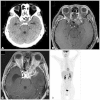Multimodal Treatment of Skull Base Inflammatory Pseudotumor: Case Report
- PMID: 26605269
- PMCID: PMC4656889
- DOI: 10.14791/btrt.2015.3.2.122
Multimodal Treatment of Skull Base Inflammatory Pseudotumor: Case Report
Abstract
lnflammatory pseudotumor (IPT) is a rare, non-neoplastic inflammatory process. It is most commonly occurs in the orbit, but extension into brain parenchyma is uncommon. In a confirmed case of IPT, most cases show good improvement with steroid theraphy. A 50-year-old man with progressive left-eye visual disturbance and mass lesion was admitted in a hospital. A left orbital mass biopsy revealed what was highly suspected as an inflammatory pseudotumor. Steroid pulse therapy with dexamethasone, radiation therapy, and chemotherapy with amphotericin B were performed, but they were not effective in improving the condition of the patient. Revision open surgery was then performed. A follow-up brain enhancement computerized tomography showed an enlarged mass volume and hydrocephalus with periventricular enhancement. As an additional procedure, ventriculoperitoneal shunt and tuberculosis medication were administered. About 2 weeks later, clinical symptoms and radiologic findings improved. We present a case of intra-cranial IPT and discuss further treatment methods.
Keywords: Cavernous sinus; Central nervous system; Granuloma; Sphenoid sinus.
Conflict of interest statement
The authors have no financial conflicts of interest.
Figures



References
-
- Gandhi RH, Li L, Qian J, Kuo YH. Intraventricular inflammatory pseudotumor: report of two cases and review of the literature. Neuropathology. 2011;31:446–454. - PubMed
-
- Ohue S, Kohno S, Matsui S, Kumon Y, Ohnishi T. Inflammatory pseudotumor in the lateral ventricle. Case report. Neurol Med Chir (Tokyo) 2012;52:599–602. - PubMed
-
- Lin YJ, Yang TM, Lin JW, Song MZ, Lee TC. Posterior fossa intracranial inflammatory pseudotumor: a case report and literature review. Surg Neurol. 2009;72:712–716. discussion 716. - PubMed
LinkOut - more resources
Full Text Sources
Other Literature Sources
Research Materials

